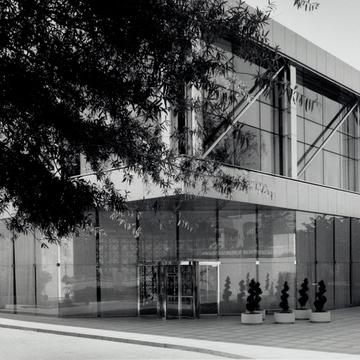Initially it does not seem that Middle Eastern building traditions influenced Paul Vieyra's design for the Kuwait Chancery in any way. Its form and materials—an off-white stainless steel and tinted-glass cube—are integral to the whole design concept of the high-tech phase of modernism. The cube set on a paved terrace is only partly visible from the street, with the entry cut into its northeast corner. This focus on the diagonal informs the architect's remaining design decisions. Four large second-floor windows on adjacent sides are pulled to the entry corner, their diagonal braces pointing downward to it. The lobby is dominated by a square reception desk rotated 90 degrees to the entry and partially enclosed by light metal screens with a small repetitive pattern derived from Islamic geometric decoration. Corner entry and rotated squares were integral to the vocabulary of this intensely geometric phase of late modernism. On an abstract intellectual level (which this building exemplifies), the entire building is an intricate and flat geometric pattern exploded in scale and made three dimensional and architectonic. Both the flat roof and the floors are cantilevered from massive square pylons; additional floors beneath the entry level are terraced at the rear.
You are here
Embassy of Kuwait, Chancery
If SAH Archipedia has been useful to you, please consider supporting it.
SAH Archipedia tells the story of the United States through its buildings, landscapes, and cities. This freely available resource empowers the public with authoritative knowledge that deepens their understanding and appreciation of the built environment. But the Society of Architectural Historians, which created SAH Archipedia with University of Virginia Press, needs your support to maintain the high-caliber research, writing, photography, cartography, editing, design, and programming that make SAH Archipedia a trusted online resource available to all who value the history of place, heritage tourism, and learning.

